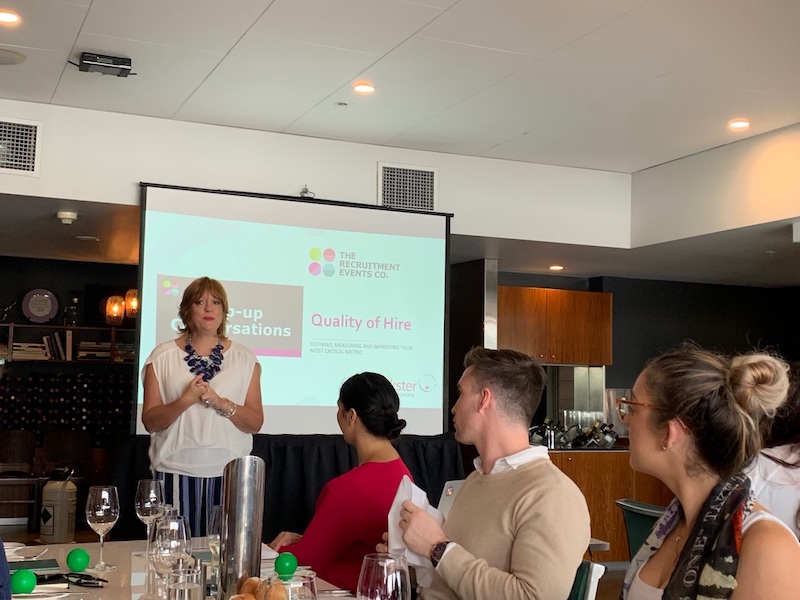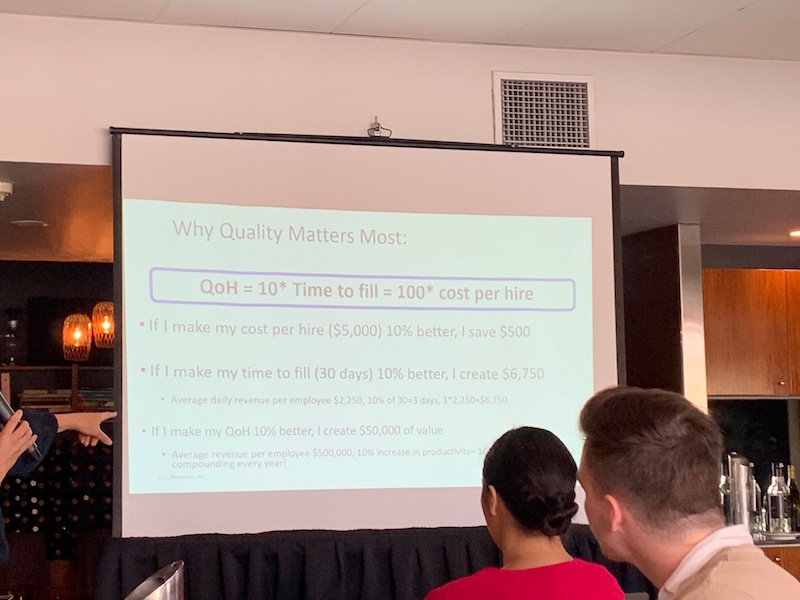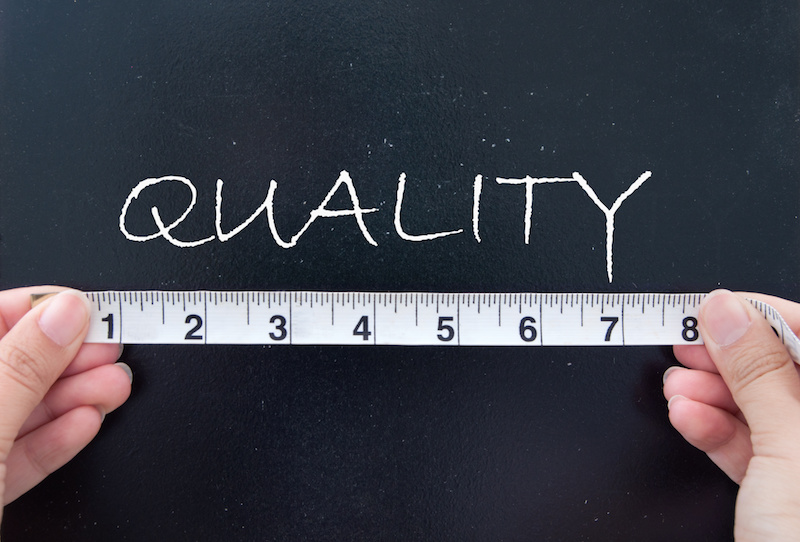What recruitment metrics are you tracking? Forget about time to fill or cost per hire. The single most important metric you can track is quality of hire. COO and Co-Founder of Checkster, Claudine Descheemaecker, shares why (and how you can do it!).
The Recruitment Events Co. Australia and Checkster attracted recruiters and talent acquisition leaders from around Brisbane to attend their recent event, “Quality of Hire – Defining, Measuring and Improving your most critical metric”. Among attendees were recruitment representatives from Findex, SwanCare, City Beach, Super Retail Group, Allianz and more. The group converged at Alchemy at Eagle Street Pier, Brisbane’s luxury restaurant and bar destination with the city’s best view of the Story Bridge, to enjoy an afternoon of fine food, good conversation, recruitment trends and key insights.
The Recruitment Events Co. Australia hosts free information sessions with a variety of vendors exclusively for in-house recruiters, resourcing and HR professionals. During this event, host Andrea Kirby, Director for The Recruitment Events Co. Australia, welcomed guests and introduced guest speaker, COO and Co-Founder of Checkster, Claudine Descheemaecker.

You may be familiar with Checkster from their automated reference-checking technology, but in fact, Checkster offers a range of web-based talent decision tools to provide human resources, recruiters and hiring managers certainty in new hire activities.


Descheemaecker captured her audience’s attention in her opening statement, “your approach to hiring is all wrong”, referring to Peter Capelli’s article of the same name published in Harvard Business Review. As she explained, quality of hire is ten times more impactful than measuring time to fill, and one hundred times more impactful than cost per hire.
“Quality of hire is ten times more impactful than measuring time to fill, and one hundred times more impactful than cost per hire.”
Why? According to calculations about why quality matters most
- If you improve your cost per hire ($5,000) by 10%, you save $500
- If you improve your time to fill (30 days) by 10%, you save $6,750
- If I improve your QoH by 10%, you create $50,000 of value
(Calculations are based on average daily revenue per employee of $2,250, 10% of 30=3 days, 3*2,250=$6,750. Average revenue per employee $500,000, 10% increase in productivity= 10%*$500,000 = $50,000 compounding every year!)
Few organisations measure their quality of hire, and even fewer do it well. Understanding quality of hire will enable you to make the best talent decisions
According to Global Recruiting Trends 2016, 39% of talent leaders agree that quality of hire is the single most valuable metric to track performance. 60% of talent leaders report identifying quality hires as their top challenge of 2019, yet only 2% have a framework to measure quality.
It starts with data
Data is where the world is going. It is becoming more and more crucial in recruitment. Having a large volume of data (and a way to interpret it through smart systems) enables you to see patterns and correlations.
“You can start to see averages,” said Descheemaecker. “If a candidate doesn’t meet an average metric, it doesn’t mean they won’t be successful in a role, but it does give you a comparison point so that you can start to see patterns. For example, one client we worked with discovered a direct correlation between the time it took for candidates to respond with reference details, and their tenure.”
A smart, integrated data system enables all your data to “talk” together. Data can include everything from employee experience, feedback from interviewers, reference insights, new hire experience, hiring manager experience, and exit interviews.
“Quality should be the central metric in all your strategy because it is the most influential ROI metric.”
It is a foundational metric for AI feedback loops. The future of recruitment involves AI, and AI only happens with data
A scary metric to own and prove?
Are we good at hiring? According to Checkster’s research, 26% of hiring managers have buyers remorse, as do 18% of new hires.
Some talent acquisition leaders may be reluctant to own the quality of hire metric, fearing its implications. But as Descheemaecker explains, its hiring managers who make the decision.
“Talent acquisition is responsible for candidates, but hiring managers make the decision. So don’t be afraid to own it. You can use it to create better frameworks for hiring managers to make the right decision and provide them with more support, knowledge and guidance. Results are not purely dependent on talent acquisition.”
Another interesting thing to consider is that sourcing responsibilities may be taken over by machine learning in years to come, so being responsible for data is a way to stay ahead.
What is quality anyways?
Interestingly, one in three companies stated that they would like to track quality of hire, but they don’t know how to start.
Descheemaecker separated attendees into small groups and asked them to consider the definition of “quality”, for how can you measure something that is not yet defined?
Only 26% of organisations have defined what “quality” means in terms of hiring.
According to the simple definition from Checkster, “quality of hire is a great team member”. But what is a great team member? A great team member has five core attributes:
- Inspiration – they can get the best out of their team
- Experience – they feel fulfilled in their role and want to stay with your organisation (retention)
- Fit – they add to your organisation’s culture and values and are pleasant to work with
- Results – they produce the results expected in the role
- Integrity – they are someone you can trust who do things they say they will.
According to Checkster, 85 years of research shows that the best assessments to determine quality hires are:
- work sample test
- structured interviews
- general mental ability tests
- peer ratings.
So take this into consideration when designing your shortlisting and interview strategy.
How can you measure quality?
“Too often, the discussion of quality of hire is confused with selection practices and not an employee’s experience once onboard. Organisations need to start by looking at what are the characteristics of a great employee first (post-hire data). Then, look at how we can try to predict those among candidates.”
Performance data has limitations because typically after a year, it is too late. It’s important to understand new hires’ experience from when they first begin at your organisation.
Descheemaecker then recommended to conduct 1, 30, 60 and 90-day check-ins with new hires, each time, speaking with the hiring manager, and asking questions that relate to quality of hire, for example:
- Can you trust them?
- Do they fit into the team?
- Are they accomplishing tasks?
Then she recommends speaking to the new hire and asking opinions from their subordinates and peers, which reduces the impact of bias.
Next steps
Descheemaecker concluded the presentation with powerful insights and recommendations on the next steps for recruiters to take.
“Organisations are overspending on sourcing talent by 80%. With the huge impact better quality can make, dedicating 20% of your budget is out of proportion to the results it yields.”
Descheemaecker recommended measuring and improving the quality of your hires, using data to inform your decision making, conducting regular check-ins with new hires, hiring managers, peers and other colleagues.
“If you are not resourced enough to use systems and technology, it is possible to track these metrics yourself using Excel. Just use something!”
Own the metric. Start measuring, use data, and identify trends. Design your shortlisting process strategically to assess quality. Conduct regular check-ins with hiring managers, new hires, their subordinates, and peers. Provide hiring managers with useful frameworks and recommendations to improve quality of hire.
What are your thoughts on measuring quality of hire? Share a comment below.
Find out more about The Recruitment Events Co. Australia
Find out more about Checkster.

